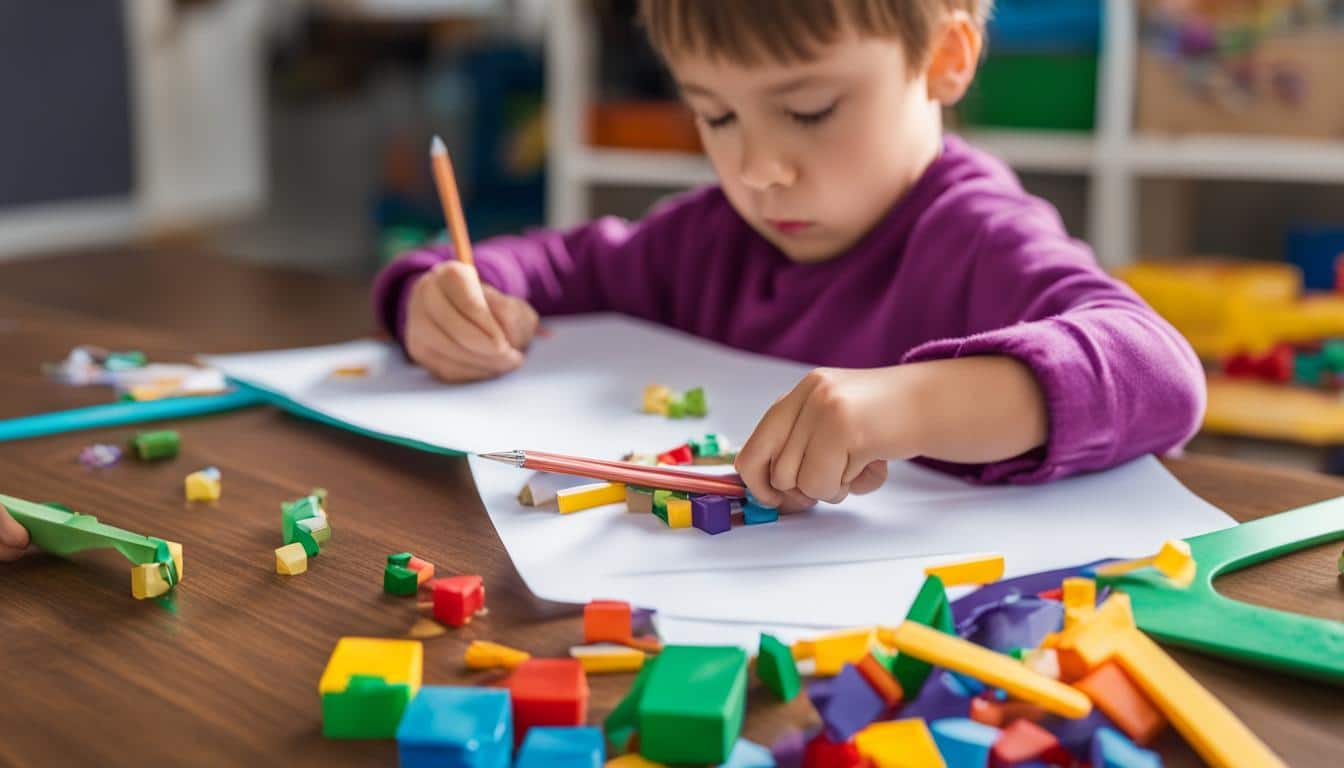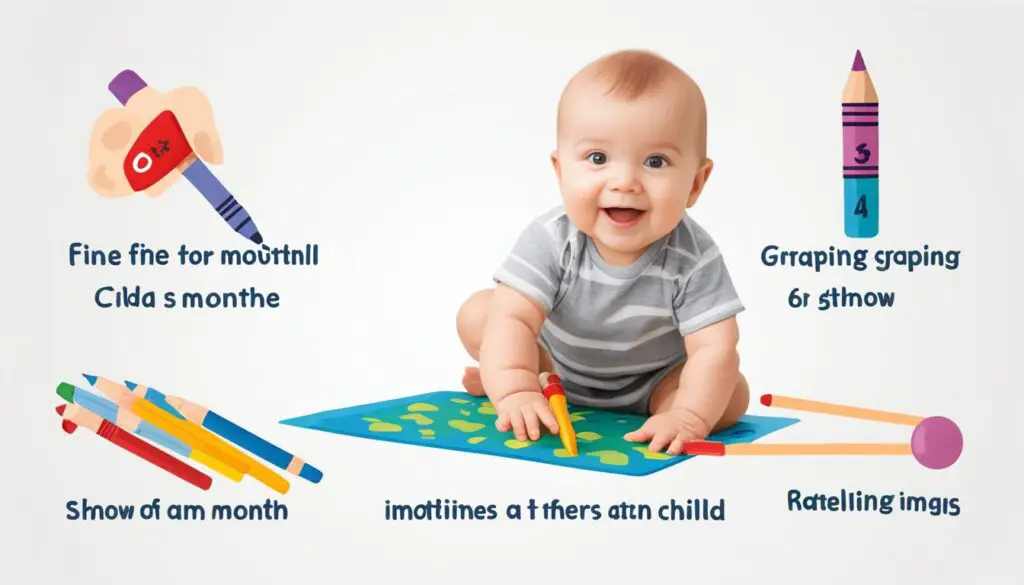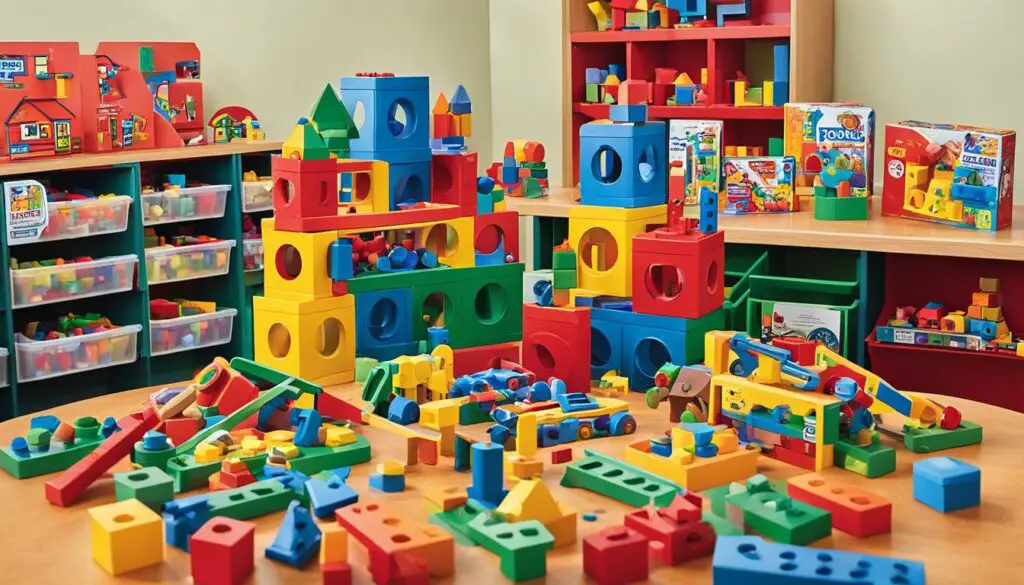
Enhancing Fine Motor Skills in Young Children
As a parent or educator, you may wonder why fine motor skills matter in a child’s development and learning journey. Fine motor skills refer to the small movements of hands, fingers, and wrists necessary for daily life activities such as writing, drawing, and using utensils. These skills are crucial for children’s growth and development and should be nurtured from a young age.
In this article, I will discuss why enhancing fine motor skills in children is important and provide practical tips and activities to foster their development.
Key Takeaways:
- Fine motor skills are essential for daily life activities and overall development in young children.
- Nurturing fine motor skills should start at a young age.
- Practical tips and activities can help enhance fine motor skills in children.
- Enhancing fine motor skills can improve hand-eye coordination and cognitive development.
- Play-based learning is an effective way to foster fine motor skill development in children.
Understanding Fine Motor Skills
Before we begin discussing the strategies to enhance fine motor skills in children, let’s first understand what we mean by fine motor skills, hand-eye coordination, and dexterity.
Fine motor skills involve the use of small muscles, like those in our hands and fingers, to perform delicate movements that require precision. Examples of these abilities involve grasping, picking up small objects, and writing.
Hand-eye coordination refers to the ability to execute tasks that require visual perception and precise hand movements. Activities such as catching a ball or threading a needle involve hand-eye coordination.
Dexterity is the skill to execute complex hand movements with ease and control. It involves strength, flexibility, and excellent motor ability. Dexterity skills are important for daily activities like buttoning a shirt or typing on a keyboard.
“Fine motor skills are essential for everyday living. They allow children to perform tasks that enable them to become independent and capable individuals.”
Enhancing these abilities in children can positively affect their overall development and learning journey.
Fine Motor Milestones by Age
Children develop fine motor skills at different rates. It’s essential to know what milestones to expect at each stage of the developmental process to foster optimal growth. Here are the expected milestones by age:
0-6 Months
- Grasping: Newborns can grasp objects with their entire hand reflexively.
- Hand to mouth: Infants bring their hands to their mouths to explore objects.
6-12 Months
- Palmar grasp: Infants can grasp objects with their entire hand intentionally.
- Raking grasp: Infants can rake smaller items closer and grasp them with their palm.
- Pincher grasp: Infants can hold an object between their thumb and first finger.
- Waving: Infants can wave by lifting their hand and moving their wrist.
1-2 Years
- Tower building: Toddlers can stack blocks to make a tower.
- Drawing: Toddlers can scribble and make marks on paper using a crayon or similar device.
- Finger painting: Toddlers can use fingers to paint or draw on paper.
- Threading: Toddlers can thread large beads onto a string.
2-3 Years
- Manipulation: Toddlers can manipulate smaller objects with their hands, such as using scissors or building with Legos.
- Copying shapes: Toddlers can copy basic shapes using a pencil or crayon.
- Cutting: Toddlers can learn to use child-safe scissors to cut paper.
3-4 Years
- Tracing: Children can trace simple shapes using a pencil or crayon.
- Using utensils: Children can use utensils to eat, such as a fork, knife and spoon.
- Building: Children can build intricate structures using blocks and other materials.
- Threading: Children can thread smaller beads onto a string.
4-5 Years
- Drawing and coloring: Children can draw and color within the lines using a pencil or crayon.
- Puzzles: Children can complete more complex puzzles with smaller pieces.
- Cutting: Children can learn to cut more complex shapes and curves using scissors.
Age-appropriate activities are essential for promoting fine motor development. Offering your child challenging but achievable tasks at their developmental stage can help them to reach these milestones.

Skill-Building Toys and Games
Introducing skill-building toys and games is an excellent way to promote fine motor skills in children. Not only are they fun and engaging, but they also help develop hand strength, finger coordination, and precision. Here are some examples of toys and games that can aid in fine motor skill development:
Building Blocks
Building blocks are fantastic for improving fine motor skills. Children can develop finger coordination and precision by stacking the blocks in various formations. Additionally, building blocks can help with hand-eye coordination and spatial reasoning.

Puzzles
Puzzles are an excellent way to improve problem-solving skills, hand-eye coordination, and fine motor skills. Children must use their fingers to manipulate the pieces into place, honing their finger strength and control. Choose age-appropriate puzzles to ensure success and engagement.
Play Dough
Play dough is a fun and creative way to develop fine motor skills. Children can roll, shape, and cut the dough, promoting hand strength and finger coordination. Additionally, play dough can be used for sensory play and stress relief.
Threading Beads
Threading beads onto strings or wires can help develop hand-eye coordination, finger strength, and precision. Children can create their necklaces and bracelets, fostering creativity and imagination along with fine motor skills.
These are just a few examples of skill-building toys and games that can aid in enhancing children’s fine motor skills. When choosing skill-building toys and games, remember to consider age-appropriateness and ensure they are enjoyable and engaging for the child.
Hands-On Activities for Fine Motor Development
Hands-on activities are an exciting way to engage children in fine motor skill development. Incorporating sensory play into these activities can make them even more enjoyable. Here are some activities that you can try:
Play-Dough Fun
Playing with play-dough is an excellent way to improve finger dexterity and hand muscles. Children can roll, cut, shape, and squeeze the dough to enhance fine motor control. You can even add different colors and scents to make it more sensory.
Threading Beads
Threading beads onto a string or pipe cleaner can help children develop hand-eye coordination and improve their pincer grasp. You can use different-sized beads and strings to make this activity more challenging.
Finger Painting
Finger painting is a fun and messy way to enhance fine motor development. Children can use their fingers to make different shapes and lines while enhancing their finger strength and control. You can try different textures like pudding, yogurt, or shaving cream to make it more sensory.
Sorting Games
Sorting games, such as sorting buttons or beads by size or color, can help children improve fine motor and hand-eye coordination skills. You can even use tongs or tweezers to make it more challenging.
“Hands-on activities can engage children in the learning process while promoting fine motor development. Sensory play can make these activities more enjoyable and beneficial for children.”
Building Hand Strength and Coordination
Developing hand strength and coordination is crucial for improving fine motor skills in children. It can also enhance their overall physical abilities and improve their dexterity.
One of the simplest ways to increase hand strength is by squeezing a stress ball. Not only is this an easy way to strengthen hand muscles, but it can also be a great stress reliever for both children and adults.
Another method is to use hand grip strengtheners, which come in various shapes and sizes. They can help build finger and hand strength gradually over time. Additionally, performing hand stretches and exercises, such as finger taps or finger curls, can improve hand coordination and grip strength.
Sensory play is another effective way to improve hand strength and coordination. Activities like playing with sand or water can strengthen hand muscles as children use their fingers to scoop, grab, and pour.
Overall, building hand strength and coordination requires consistency and practice. Parents and educators can encourage children to engage in these activities regularly to see significant improvements in their fine motor skills.
Environmental Modifications for Fine Motor Skills
For children with fine motor challenges, environmental modifications and adaptive tools can help create a supportive and nurturing environment. Simple changes can be made at home and school to reduce frustration and support their growth.
Some environmental modifications that can be made include:
- Adjusting the height of furniture so children can comfortably reach workspaces
- Ensuring proper lighting to reduce eye strain and improve visibility
- Creating a clutter-free working environment to help children focus better
- Providing comfortable seating that promotes good posture and grip strength
- Using non-slip materials on surfaces to prevent items from slipping around
Adaptive tools and assistive devices are also useful for children with fine motor challenges. These tools and devices can help improve their grip, hand strength, and coordination while engaging in activities. Some examples of adaptive tools and assistive devices include:
| Adaptive Tool/Assistive Device | Function |
|---|---|
| Pencil grips | Enable children to grip pencils and other writing instruments more comfortably and with greater stability |
| Weighted utensils and cups | Provide proprioceptive input and help stabilize hands while eating and drinking |
| Button hooks and zipper pulls | Assist with dressing by providing a wider grasp and greater leverage on smaller items |
| Slant boards | Provide an angled surface for writing, drawing, and other activities that can help reduce wrist strain and improve hand positioning |
By making environmental modifications and introducing adaptive tools and assistive devices, children can be better supported in their fine motor skill development. This leads to increased confidence, participation, and success in activities that require fine motor skills.
Conclusion
In conclusion, enhancing fine motor skills in young children is crucial for their overall development and learning journey. As a copywriting journalist, I have shared several practical tips and activities that parents and educators can use to support and foster their children’s fine motor skill development.
Understanding what fine motor skills are and their significance in children’s overall development is the first step. As they grow, it’s essential to focus on age-appropriate activities, skill-building toys and games, hands-on activities, and environmental modifications that can aid in their fine motor skill improvement.
Remember to make it fun and engaging for the children and incorporate play-based learning and sensory play into the activities. Building hand strength and coordination is also essential for fine motor skill improvement; therefore, ensure that you include exercises and activities that focus on this aspect as well.
By implementing these tips and activities consistently, parents and educators can help children enhance their fine motor skills. With time, the children will gain better hand-eye coordination, dexterity, and grip strength, leading to better performance in daily tasks such as writing, drawing, and cutting.
Thank you for reading, and I hope this article helps you in enhancing the fine motor skills of the young children in your care.
FAQ
What are fine motor skills?
Fine motor skills refer to the coordination of small muscles in the hands and fingers, allowing children to perform tasks that require precise movements and control.
Why are fine motor skills important in children’s development?
Fine motor skills are crucial for various everyday activities, such as writing, buttoning clothes, and using utensils. They also play a significant role in cognitive development and hand-eye coordination.
How can I enhance fine motor skills in young children?
There are several ways to enhance fine motor skills, including engaging in hands-on activities, providing skill-building toys and games, and focusing on building hand strength and coordination through exercises.
Are there specific fine motor milestones by age?
Yes, each age group has specific fine motor milestones. These milestones can vary, but they generally involve mastering skills like grasping, stacking, and manipulating small objects.
What are some examples of hands-on activities for fine motor development?
Examples of hands-on activities for fine motor development include playing with play-dough, threading beads onto strings, and engaging in finger painting.
How can I help children build hand strength and coordination?
Activities such as squeezing stress balls, using tongs or tweezers to pick up small objects, and playing with construction toys that require manipulation can help build hand strength and coordination.
What are some environmental modifications for fine motor skills?
Environmental modifications include providing adaptive tools like pencil grips or adapted scissors, arranging workspaces to minimize distractions, and using assistive devices for children with specific needs.